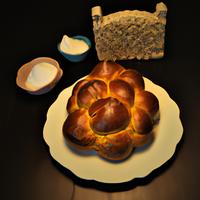
1 serving (60 grams) contains 198 calories, 4.8 grams of protein, 6.0 grams of fat, and 30.0 grams of carbohydrates.

Log this food in SnapCalorie

Nutrition Information
Calories |
792 | ||
|---|---|---|---|
% Daily Value* |
|||
| Total Fat | 24 g | 30% | |
| Saturated Fat | 14.4 g | 72% | |
| Polyunsaturated Fat | 0 g | ||
| Cholesterol | 72 mg | 24% | |
| Sodium | 960 mg | 41% | |
| Total Carbohydrates | 120 g | 43% | |
| Dietary Fiber | 4.8 g | 17% | |
| Sugars | 9.6 g | ||
| protein | 19.2 g | 38% | |
| Vitamin D | 0 mcg | 0% | |
| Calcium | 72 mg | 5% | |
| Iron | 3.6 mg | 20% | |
| Potassium | 192 mg | 4% | |
* Percent Daily Values are based on a 2,000 calorie diet. Your daily values may be higher or lower depending on your calorie needs.
Food Attributes
Source of Calories
About Butterzopf
Butterzopf, a traditional Swiss bread, is known for its rich taste and beautiful braided appearance. Made primarily from white flour, milk, butter, eggs, yeast, sugar, and salt, this bread has a soft texture and golden crust. It is commonly enjoyed during breakfast or brunch, often with jams, honey, or cheeses. Though Butterzopf provides energy through its carbohydrates, it’s less nutrient-dense than whole-grain breads due to the use of refined white flour. The high butter content contributes to its rich flavor but also increases saturated fats, making moderation key for a healthy diet. Originating in Switzerland, Butterzopf reflects the country’s love for artisanal baking and celebratory breads. While it may not be the healthiest bread option, its occasional enjoyment as part of a balanced diet offers a delightful treat tied to Swiss culinary tradition.



